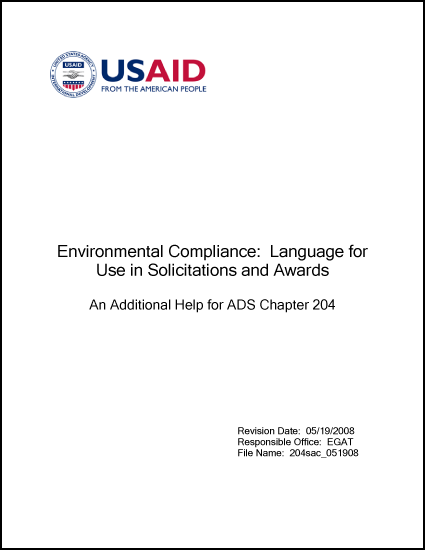- Environmental Procedures
- Environmental Compliance Officers
- Environmental Compliance Database (ECD)
- Safeguarding the Environment Over the Program Cycle
- 22 CFR 216: USAID's EIA Process
- Environmental Documentation: Types & Templates
- Mitigation, Monitoring & Reporting
- Environmental Compliance and Procurement
- Mission Processes; Roles and Responsibilities
- Environmental Procedures & Climate Risk Management
- Special Compliance Topics
- Principles of EIA
- Social Impact Assessment Principles
- Sectoral Environmental and Social Best Practices
- Biodiversity and Tropical Forest Analyses
- Training: Courses and Calendar
- Laws, Regulations and Policies
- Foreign Language Resources
- USAID Bureaus
- Safeguarding the Environment: Mission Support
- Europe & Eurasia
- Global Health
Speeches Shim

USAID mandatory operating policy requires “incorporating environmental factors and mitigative measures identified in IEEs, EAs, and EISs, as appropriate, in the design and the implementation instruments for programs, projects, activities or amendments.” (Automated Directives System (ADS) 204.3.4(a)(6))
Best practice requires that:
- Proposals address qualifications and proposed approaches to compliance for environmentally complex activities.
- Implementing partners (IPs) verify current and planned activities annually against the scope of the relevant 22 CFR 216 environmental compliance documentation (i.e. request for categorical exclusion (RCE); Initial Environmental Examination (IEE), or Environmental Assessment (EA))
- A complete Environmental Mitigation and Monitoring Plan (EMMP) exists or is developed.
- Activity workplans and budgets integrate the EMMP.
- IP activity implementation reporting (e.g. quarterly and annual reports) include the status of EMMP implementation.
This language best ensures that the necessary capacity, resources, and processes for compliance with required environmental mitigation and monitoring is in place. It also ensures that USAID has the information needed to oversee environmental compliance.
The ADS Help Document Environmental Compliance: Language for Use in Solicitations and Awards (ECL) provides step-by-step guidance and boilerplate to generate best practice language for all solicitations and awards. Its use is optional, but strongly encouraged by all Bureau Environmental Officers (BEOs).
- Access the ECL
- Download the ECL factsheet [updated version forthcoming] for a summary of the goals, purposes, and value of the EC

Comment
Make a general inquiry or suggest an improvement.